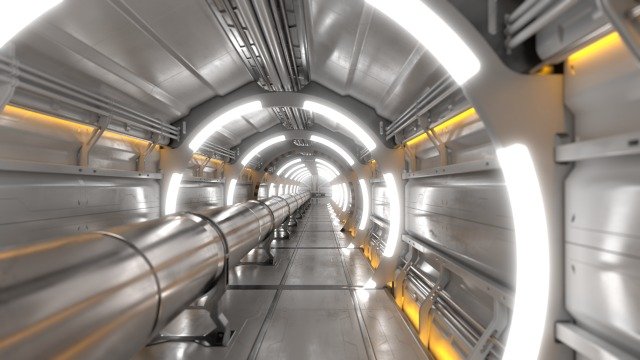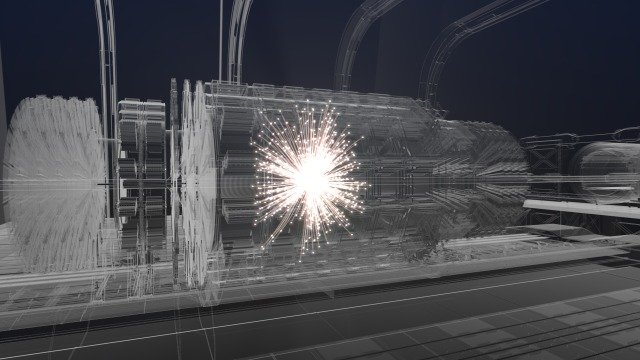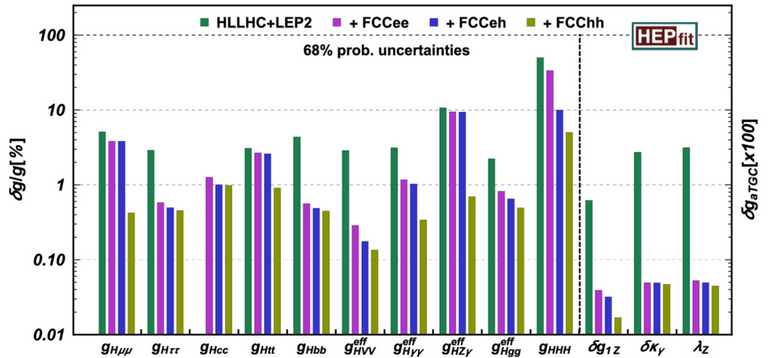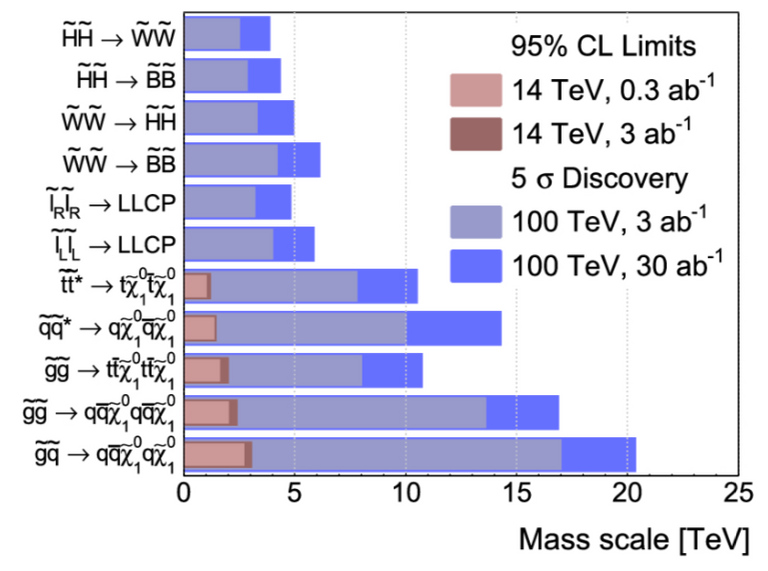Many particle physicists currently investigate what should be the next large high-energy physics facility to be built, as a successor to the Large Hadron Collider at CERN. Last December, I contributed to a publication in which we tried to assess the best choice from the European standpoint, after accounting for the various (European) options on the market.

[image credits: open photos @ CERN]
The machine that is presently exploited in Europe, the LHC at CERN, has already done a lot. After two successful runs of operation, it indeed discovered the Higgs boson in 2012 and constrained quite strongly many options for new phenomena. Whilst we have deep indications we should discover something new at some point, the form of this new physics is completely unknown.
Moreover, the moment at which we should see something is also unknown. This could happen at the LHC, or not. There is no no-lose theorem here… The next 35 years of data taking at the LHC are therefore really exciting as the future results may shed some light on physics beyond the Standard Model.
Particle physics has entered an era of exploration and we do not know what we may find, the deep details about how to find it and when this will happen. This is after all what exploration is about: trying to discover new phenomena without any certainty about finding them soon.
The crucial point is that along this exploration, one should consider all options and make sure not to miss anything.
Why worrying about the next steps today?
The simple answer is that we are already late!
We need time to understand what are the options, how to build each of them, select the best one and effectively build it. We can take the LHC as an example. Whilst its exploitation started in 2008, the first studies date back from the mid 1980s. Moreover, the machine will run until roughly 2040. This is the kind of timeframe we are talking about here!

[image credits: open photos @ CERN]
In the paper of last December, I collaborated a group of researchers and we investigated the various European options. In other words, we assessed all options that could be built at CERN and lead to a machine that would start at the end of the LHC operations.
The project that we considered as the best for European particle physics is the so-called FCC project where the FCC acronym simply stands for a Future Circular Collider. This consist in a circular collider that is long of 100 kilometres and in which various types of particles can collide.
This machine has in particular the possibility to operate in an electron-positron collision mode and in a proton-proton mode. And there is no need to choose! We could have both, which would guarantee 100 years of physics at CERN! Moreover, having the two options operating one after the other could be achieved at a decent price (of several tens of billions, but spread over many years and many countries).
A future electron-positron collider at CERN
In its electron-positron collider mode, the machine is proposed to produce 1,000,000 Higgs bosons, 1,000,000 top quarks, 5,000,000,000 Z bosons and 100,000,000 W bosons. Those are the heaviest particles of the Standard Model, and having so many of them will all us to probe their properties with an unprecedented precision.
From the current results of the LHC, we know that new phenomena are elusive: there is indeed no trace of them so far. Theoretically, we however also know they should be there. One potential avenue consists in scrutinising very deeply all known particles and hunt for deviations in their properties.
Let’s now quantify a bit the improvement in precision we are after with the new collider in the picture below.

[image credits: arXiv]
Each entry corresponds to the accuracy at which a given property of the Higgs boson can be measured at different colliders. The smaller is the bar, the better is the measurement. The expectation from the entire LHC run is given in green, whilst the improvements arising from a future electron-positron collider (FCC-ee) is shown in purple.
This figure shows that where we expect a precision of 1–10% at the LHC, the FCC would allow for a sub-percent precision for many quantities. This consists in the main goal of a future electron-positron collider programme at CERN: provide handles on new phenomena that could hide as tiny deviations in the properties of known particles.
A high-energy proton-proton collider at CERN
A big advantage of having an electron-positron machine in a 100 km tunnel is that it can be easily upgraded into a very energetic proton-proton collider at a decent cost (of again a couple of tens of billions USD, which is cheap after accounting for the timescale and the spread over the participating countries).
This corresponds to another avenue to new phenomena that could be explored. With a 100 km tunnel at hand, we could indeed get proton-proton collisions occurring at an energy larger than 7 times the LHC energy, and at a much larger rate.
In this way, we will get handles on more energetic and rarer phenomena. The key Standard Model measurements would be those related to the self-interactions of the Higgs boson, that are barely reachable at the LHC (so that there is a lot of room for the unexpected in those). In addition, dark matter, supersymmetry or compositeness will be pushed to more extreme corners, to name a few of the best candidates for physics beyond the Standard Model.

[image credits: arXiv]
This is illustrated with the above figure, that describes the reach in mass for various supersymmetric processes. In supersymmetric theories, each known particle possesses a partner that is heavily searched for. The expectation of those searches, if run at a potential future FCC collider at CERN, are shown as blue bars on the figure. The mass scale corresponds to how heavy could these new particles be to be discovered. For comparison, the brown coloured bars show the capabilities of the LHC.
Take your favourite model, similar figures can be made! In a few words, the mass reach for any potential new particle will be extended by a lot thanks to the FCC!
Summary - a vibrant high-energy physics community
This programme around the two discussed future colliders has clear benefits for the particle physics community. We will learn more about the Standard Model and the physics that lies beyond it. In other words, with 80-100 years of physics experiments we will get a better and deeper understanding of how the universe works.
It is true that the machine costs are not negligible at all (several tens of billions of USD). We however must keep in mind that the budget is spread across many countries and over many decades.
In exchange, a highly-qualified work force will be trained within the course of the project, both for the design of the machine, its operation and data analysis. This is where the benefits for the society comes in: high qualification by training!
Moreover, building the project requires non-existing (yet) high-field magnetics, complex cryogeny, novel civil engineering techniques, the development of new computing methods, data handling, and so on. All developments will come back to the society, for free, without any patent.
Will governments pay for this? That is a question I haven’t the answer for now… But I hope so, honestly. I personally think that the cost-benefit analysis is in favour of the society.
PS: This article has been formatted for the STEMsocial front-end. Please see here for a better reading.
Great summary of the considerations that must go into such an immense collaborative project.
The age of stumbling across gold is over! Exploration of this sort mandates huge investments with little guarantee of results. Other than for pure knowledge sake, what are some applications of the information that may come out of this project that would enrich everyday life?
@dhimmel will be happy to hear this!
Really many people are indeed involved. On the physics side, this is testified, for instance, by the number of authors of this FCC-ee and this FCC-hh publication (yeah, I signed both ;) ).
This is true. With the LHC, we knew in advance that either the Higgs boson would be found, or we will have to revise the Standard Model (in the no-Higgs case). So that we have a no-lose theorem: there will be something to learn.
Now, the picture is different: we have no certainty of anything. We all rely on how kind nature is with us, somehow ;)
Pure knowledge is very hard to give any value, although it is really valuable. There, this should be ignored from any reasonable cost-benefit analysis. Especially as a new understanding of the universe functioning won't change our lives in any sense.
The immediate value (let's call it that way) is elsewhere.
First, there is a scientific value (the publications that will stem from the machine).
Second, there is a human capital formation value: all early-stage researchers that will be trained on the project may go later into the private sector. It has been demonstrated that their salary is generally higher when compared to people of the same age category not being formed by research (cf. the LHC).
Third, many private companies will be involved in the development of the non-existing technologies required by the project. This is the somehow 'learning by doing' thingie.
On top of that, we have the transfer of knowledge from the public to the private sector. For instance, many pieces of software have been developed by particle physics research and are now used everywhere (not even speaking about the web itself).
Finally, we may even add the outreach activities as these can be converted into a benefit, somehow.
I know this is not a full analysis (this may go into a full post if I wanted to give more details), but I hope this will give you (and possibly @dhimmel) enough insights!
Those are all phenomenal points! I mostly asked to get your take on it, as I agree that no cost-benefit analysis will capture the positive outcomes of these two projects. Thanks for sharing and may leptons collide!
Hopefully I will see that in my researcher lifetime :)
Thank you, @lemouth, for sharing this adventure with us. Because my training is in history, I kept thinking as I read of explorers in early ages. These explorers had to apply to monarchs for better ships, for cash disbursements to finance voyages. I thought of sputnik, and the early U.S. space program. In that case, the U. S. was 'late'.
"The simple answer is that we are already late!"
I hope governments are able to understand the importance of your work. If you are writing the proposal (with your clarity and passion) there's a good chance they will :)
To get there, there is a couple of sentences from the conclusions of our article that I would like to quote:
I used to feel quite intimidated by all the unfamiliar terms that inevitably dot your posts. However, once I got past that feeling I became able to see how many parallels there are between your field and mine, in particular: the eager exploration of realms packed with unknown, promising findings.
I do wish the plans and ambitions of the particle physics' community come true. Given how abstract all of this may be for the lay person, highlighting how society in general can benefit from such a grand (costly) enterprise is thoughtful and considerate :)
Believe me, I kept them to the minimum ^^ If there is any wording in particular that requires some deeper explanations, feel free to ask! I will always be there to answer.
I guess this applies to the entire science domain, doesn't it? :)
On the to-do list, we should learn how to better communicate with the general audience (this is on-going) and provide nice feedback to the public. I am confident this will happen.
Great to see that you are continuing your work and posting it on Hive. I always enjoy reading about updates from CERN
I have never stopped posting. But I have less time, which means I cannot continue with one article per week, although I would love too (I have enough topic to discuss for the rest of the weeks of this year ;) ).
To be honest, I could continue writing on my blog, but then I will have to stop developing stop for STEMsocial. And I feel it is important to do that as well (feel free to check @lemouth-dev later on today, for a small update).
Perhaps if it fits in into the overall agenda of government, they could pay for it. Science in this part of the world gets virtually nothing from the government and private sectors are busy paying strippers and singers huge money for endorsements.
The problem is that it has to fit in the agenda of many governments. And since the project is long term, even of many governments of many countries: the lifetime of a government is smaller than the project time-span.
And it is even more true for fundamental science that has to fight for surviving... We somehow need to learn how to communicate better :)
Thanks for your contribution to the STEMsocial community. Feel free to join us on discord to get to know the rest of us!
Please consider supporting our funding proposal, approving our witness (@stem.witness) or delegating to the @steemstem account (for some ROI).
Please consider using the STEMsocial app
app and including @steemstem as a beneficiary to get a stronger support.